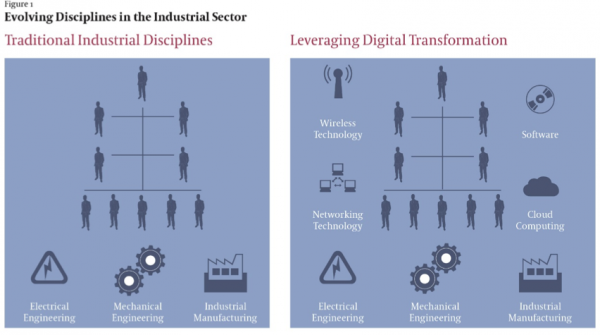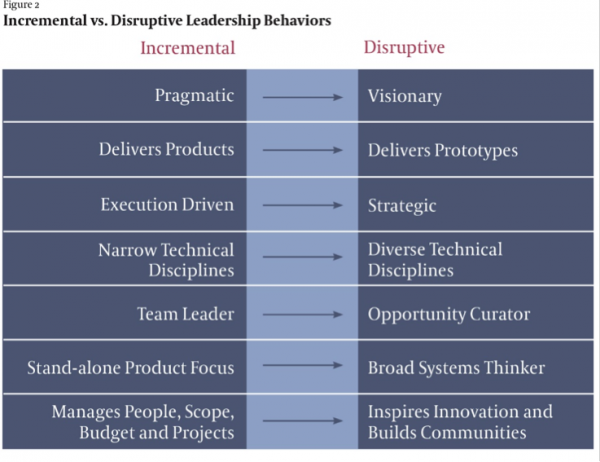Getting the Leaders You Need to Build the Systems of the Future
Feature in Industry Today (July 2015)
Disruption has a way of sneaking up on industries even when they know it is coming. This is because the shift takes place at geometric speed: slowly at first, and then with increasing acceleration. Within the industrial sector, the digital transformation of manufacturing is reaching a critical inflection point. Only a few years ago, “smart machinery” meant the ability to customize complex systems and services to customer requirements, or the optimization of global supply chains through sophisticated systems integration. These were all worthy endeavors, but ultimately represented incremental change.
Today, true disruption of the industrial sector is still in the future, but it is a future whose outlines we can clearly see in the form of elevators that can identify riders, vehicles that can predict destinations and economical 3-D printing that allows the on-demand production of otherwise obsolete parts. All of this translates into a heightened sense of urgency for industrial companies who are looking to be part of the vanguard that will define the digital future.
Fundamental Levers
To succeed in the approaching era of smart machines, industrial leaders must optimize four fundamental, highly interdependent levers:
1.Talent. The industrial sector has an advantage over other sectors experiencing disruption in that engineering and technology are already central to the business. Even so, industrial firms must now broaden their technical expertise to include components like cloud computing and processes like agile development. To fully leverage cutting-edge technology, industrial executives must forge cohesive, high-performing organizations that effectively blend diverse talent from multiple disciplines and backgrounds (see Figure 1).

2. Organizational structure. Related to the question of talent is that of how digital capability is most effectively integrated into the company. Fundamentally, there are two options, which form the ends of a spectrum. On the one hand, digital operations can be set up as a self-contained entity within the organization. This approach allows maximum freedom in establishing culture, reporting relationships, KPIs and compensation. At the same time, this makes it more difficult to leverage the benefits of innovation across the organization and risks creating a two-tier system as time goes on and smart products and processes drive more and more of a company’s offerings.
The other approach is to embed smart capabilities across the organization, which has the benefit of involving the entire organization from the start. Here the challenge is to establish a sufficient critical mass so that tangible achievements can be used as a platform for further evolution.
It is important to note that a company’s digital strategy can evolve over time or that multiple strategies can be pursued at the same time. How this strategy unfolds may also be a function of whether the organization centers its digital future on products, services or a mixture of the two, and how much of a shift that requires from where the organization is now. But understanding where a company’s strategy falls on this spectrum can help it think about the types of leaders and culture that it needs.
3. Culture. To mold diverse talent into cohesive teams, industrial companies must establish more open, collaborative cultures that place a greater value on speed, innovation, streamlined decision making and the fostering of different perspectives. To do so, industrial companies will need to expand their risk tolerance, more readily accept failure as part of the process and resist the impulse to reject breakthrough thinking as impractical and unrealistic. The most adaptive companies will balance the traditional emphasis on execution and precision with the new imperatives of fostering speed and creativity, nurturing the many different kinds of talent required to actualize convergence and then creating the cohesion to make it all work together.
But greater risk tolerance and room for creativity does not imply lower standards. To the contrary, industrial companies must also become more performance oriented. Overall, the sector has been too ready to accept average returns, with little impulse to stretch for more. Yet in certain cases, industrial CEOs (including a few who came over from sectors where profit margins traditionally run higher) have pushed their companies to be more aspirational and have forged cultures that earn returns much higher than the industry average. In short, the performance disparity that already exists within the sector suggests that the culture change needed for the era of smart machines can significantly improve earnings in the present.
4. Leadership. Traditionally, industrial companies have been led by executives whose priorities are client interface, technical excellence, differentiated quality and steady incremental gains in machine and system productivity. But in the current transformation, operational excellence will no longer suffice. There must be a reorientation of the organization to reward more risk taking and innovation, more fully develop internal talent (by exposing them to more parts of the disruption, creation and innovation process), and increasingly empower people to pursue innovation. This will require leading by values instead of control—that is, building the desired behaviors into the company DNA, then stepping back to give creative people the freedom they need to be fulfilled and effective in their work. In short, industrial executives must grow as leaders, replacing incremental leadership behaviors with disruptive ones (see Figure 2).

Six Steps toward Digital Transformation
Navigating to the industrial sector’s digital future can seem daunting. Here are six steps industrial leaders can take to help evolve their organizations and build the foundation that attracts the talent they need:
1. Create a sense of urgency. Recognize, study, and clarify the company’s strategic imperative to change. Resolve to adapt before you face a burning platform.
2. Adopt a systems mindset. The essence of digital transformation is interconnection—between machinery, servers, data, communication networks and people. Deepen company-wide awareness that your solutions will increasingly be pieces of a much larger puzzle. Craft your future value-add in a macro systems context.
3. Assess and adapt your culture. Gauge the degree to which your current culture is suited to succeed in an “unknowable” future. Increase the value you place on agility and speed, constructive risk taking, and out-of-the-box thinking. As an executive team, clearly communicate the targeted changes in cultural norms, and visibly model essential new behaviors.
4. Grow your leadership capability. Identify and promote more “horizontal thinkers” who can bring together ideas from multiple disciplines to build the machinery systems of tomorrow. Invest in attracting leaders who have successfully crafted complex, multidiscipline systems in other contexts.
5. Experiment. Big successes are born from small failures. Actively experiment with new strategies while carefully containing the risk. Build on what you learn.
6. Execute. Sustain focus on where the money comes from today as you try out new approaches and foster a more adaptive and innovative performance culture.
Industrial companies that fail to prepare for the digital future could find themselves at a significant disadvantage, while those who move decisively to adapt and seize the vast opportunities can effectively position themselves to enjoy employer of choice status, loyal customers and enviable shareholder returns.
This article was first published in Industry Today (July 2015) and is republished on this website with kind permission of the magazine.





